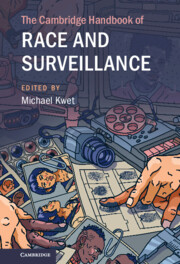Book contents
- The Cambridge Handbook of Race and Surveillance
- The Cambridge Handbook of Race and Surveillance
- Copyright page
- Contents
- Figures
- Contributors
- Acknowledgments
- 1 The Golden Age of Racial Surveillance
- 2 Sorting Identity
- 3 Imperial Mimesis
- 4 The Racialisation of British Women during the Long Nineteenth Century
- 5 Linking Caste and Surveillance
- 6 Surveillance in South Africa
- 7 Israel/Palestine, North America, and Surveillance
- 8 Colonialism’s Uneasy Legacy
- 9 China’s Surveillance and Repression in Xinjiang
- 10 Asian Americans as “the Perpetual Foreigner” under Scrutiny
- 11 The Great White Father and His Little Red Children
- 12 In a Most Excellent and Perfect Order
- 13 Surveillance and Public Schools
- 14 Surveillance and Preventing Violent Extremism
- 15 Resistance and the Politics of Surveillance and Control
- 16 Surveilled Subjects and Technologically Mediated Law Enforcement
4 - The Racialisation of British Women during the Long Nineteenth Century
How White Women’s Bodies Became Tools of Control and Surveillance
Published online by Cambridge University Press: 23 February 2023
- The Cambridge Handbook of Race and Surveillance
- The Cambridge Handbook of Race and Surveillance
- Copyright page
- Contents
- Figures
- Contributors
- Acknowledgments
- 1 The Golden Age of Racial Surveillance
- 2 Sorting Identity
- 3 Imperial Mimesis
- 4 The Racialisation of British Women during the Long Nineteenth Century
- 5 Linking Caste and Surveillance
- 6 Surveillance in South Africa
- 7 Israel/Palestine, North America, and Surveillance
- 8 Colonialism’s Uneasy Legacy
- 9 China’s Surveillance and Repression in Xinjiang
- 10 Asian Americans as “the Perpetual Foreigner” under Scrutiny
- 11 The Great White Father and His Little Red Children
- 12 In a Most Excellent and Perfect Order
- 13 Surveillance and Public Schools
- 14 Surveillance and Preventing Violent Extremism
- 15 Resistance and the Politics of Surveillance and Control
- 16 Surveilled Subjects and Technologically Mediated Law Enforcement
Summary
As David Hillman and Ulrika Maud note, ‘the body has always been a contested site’.1 This chapter applies Sara Ahmed’s position that the racialisation of bodies occurs through a differentiation between bodies on the grounds of Otherness, and argues that the period between 1780 and the outbreak of World War I in 1914 witnessed a distinctive chapter in the racialisation of British women.2 Racialisation is, as Ahmed asserts, a process that takes place in time and space, and which has ‘multiple histories’.3 Surveillance likewise can be understood as a process as much as an act, and is ‘historically present not just in technology or statecraft, but also in society and culture’.4 During this ‘long’ nineteenth century between 1780 and 1914, the long-standing idea that women were biologically distinct from men became, for the first time, legitimised by science and the Victorian state, and women’s physical bodies themselves became platforms for surveillance. In a period which has been recognised by many as a turning point for overt information collection, women became almost literal information objects.5
- Type
- Chapter
- Information
- The Cambridge Handbook of Race and Surveillance , pp. 57 - 75Publisher: Cambridge University PressPrint publication year: 2023



